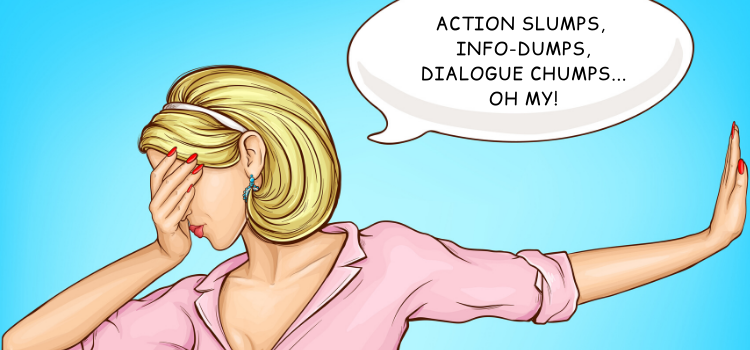
The 5 Narrative Writing Modes:
Dialogue, Action, Description, Exposition & Thought
Today we explore the five narrative writing modes every fiction and memoir writer must master for dynamic storytelling.
My research of this subject began when I shifted from screenplay assessment to fiction editing. I’d often wonder why, in film adaptations, the book was almost always better than the movie. The more I came to understand literature the more I realized that filmmakers offer their audience a fly on the wall perspective, while novelists fly off that wall and climb inside their characters’ heads. And as obvious as that may seem, it’s pretty awesome to think about the depth this offers us as narrative writers. Action, exposition, description, dialogue and thought (a.k.a interior monologue) are the five narrative modes that portray a characters’ external and internal worlds. From stomach-twisting discomfit to the thrill of rediscovering a childhood scent, nothing is off-limits. If filmmakers are all-seeing gods, novelists are all-knowing ones.
Action: What the characters are doing.
Description: The five senses (sight, sound, smell, touch, taste).
Exposition: Information and context that isn’t directly available ‘in-scene’.
Dialogue: The characters’ external speech.
Interior Monologue: The characters’ internal thoughts.
Example Narrative Writing Modes
When I first began writing scenes of an intimate nature, my technique was highly developed. It involved closing my eyes and fantasizing to my heart’s content, before scribbling the details down. I thoroughly enjoyed the process, until my editor pointed out that I’d simply written a long list of actions. He gripped her waist…She groaned as he…They cried out in ecstasy…And so it would go on, and on, and on. In my rush to explore the action, I had forgotten about the other narrative tools in my belt: description (Her hair was coarse silk in his fingers…), dialogue, (“My god, woman, you test me!”), exposition (She always wore her locks tightly pinned atop her head…) and interior monologue (Her hair alone had undone him. What hope did he have as her fingers moved to the buttons of her chemise?).
Read more about the elements of a great sex scene.
As soon as I utilized all the narrative tools in my belt, my scenes came to life. Weaving allowed me to speed up or slow down the pace of an interaction as required. Different tools would draw focus to what was important, or summarize the bits that weren’t. As my lovers left the bedroom and approached a haunted house, it was a good time to employ more description, creating a foreboding tone as they explored the spooky location. On the next page, dialogue and action offered urgency, gripping the reader in the moment as the poltergeist finally appeared. Later, when they moved to the library to do some research, a focus on exposition and interior monologue provided a breather, as well as valuable new information and insights into the characters’ feelings and backstory.
When Your Narrative Writing Modes Are Out of Whack
Some editing tools (like ProWritingAid) will assist in highlighting sections of text where narrative tools have been over or under-utilized. When working solo, keep a look out for these signs:
Too many drinks. It sounds silly, but it’s true. Novels with lots of drinking scenes—tea with grandma, cocktails or coffee with the bestie—are often static and dialogue heavy. Consider adding action that brings the scene to life and progresses the plot. I.e. Susie chats with grandma (dialogue) during a shared self-defense class (action). The killer right-hook they learn goes on to save Grandma’s life, thereby progressing the plot.
Beyond face value. Grandma and Susie might be learning self-defense and talking about a recent spate of robberies, but we’re missing a chance to go deeper. For example, Grandma is challenging Susie about the dangers of living alone, while Susie hits the punching bag and promises to buy some mace (action + dialogue). But what if silently, Susie is frustrated by Grandma’s unspoken criticism that she isn’t married like her sisters (interior monologue). Suddenly, the scene is working on three levels, instead of two. Strong dialogue is usually supported by subtext; the conflict between what’s said aloud, versus what a character is thinking and feeling.
Dump the info dumps. Exposition and backstory are vital; we can’t appreciate the significance of an event if we’re missing important context. But do we need a page of political history while our hero is fighting for his life? Likewise, dumping lots of exposition and world building in the novel’s opening scenes will cripple the pace of a story before it’s begun. It’s fine for a first draft—often writers need to get the details down just to keep them straight in their own heads. But once you start weaving, important facts should be peppered, not splattered. It’s also smart to introduce them closer to when they become relevant, so they’re fresh in the reader’s mind.
Police reports. It’s tempting to describe our sexy hero from head to foot, but most of the time we only need a few clever brushstrokes to effectively introduce a character and create a strong impression. We don’t spend long minutes fixated on details in regular life, so your characters shouldn’t either. Unless the focus of our attention is central to an important event, painstaking description will slow the pace and become distracting.
Navel-gazing. Romance is all about feeling, and interior monologue gives us an intimate glimpse inside a character’s mind. But it should be a glimpse, not a lobotomy. Avoid ‘over-explaining’ emotions and thoughts by showing more, and telling less. Love can be expressed through description, dialogue and action just as effectively. This also harks back to genre. Literary fiction is driven by intellectual insights, so it’s common to spend hours inside the head of some neurotic protagonist. In romance, the focus is entertainment, and the same approach would quickly become monotonous. For example:
Suzie couldn’t believe Grandma kept making indirect jabs about her single life. I’m not a loser! She punched the bag. I just hate men! And besides, it’s hard to date when your whole life is under scrutiny. Maybe if she gave me a little breathing space, I might actually meet someone nice. I’d like to see her face if I did! No one is ever good enough…
Etc. You get the idea!
When used well, interior monologue can be a great device. Overused, the character becomes that mad person in the park, muttering to themselves and swiping at pigeons. Keep these silent, internal lines short, and think twice about having your character speak out aloud when alone, unless it’s some cute quirk and applied in a deliberate manner. Ninety percent of the time it’s jarring and inauthentic.
Too much black. If my old screenplay professor said my script had ‘too much black’, it meant I needed to cut back on the description and exposition. Novels are of course denser in nature, and too little ink on the page could be a sign your MS is turning into a screenplay: all external action and dialogue, and not enough of the internal elements to give it depth. If you have a problematic scene, highlight the text in different colors; yellow for dialogue, blue for description, and so on. Every writer has a different style, but ideally your draft will be a rainbow tapestry of devices. If some pages are dominated by just two colors, you’re probably not utilizing all the tools in your belt.
It doesn’t take a trained eye to feel the effects of two-dimensional writing; a reader will sense a scene is flat without necessarily being able to articulate why. It’s important to honor your unique writing style, but don’t forget to weave strategically, utilize your tools, and climb deep into the hearts and minds of your cast. Just think of all those poor, long-suffering screenwriters, who would love to do the same!
Further Reading on Narrative Writing Modes…
Narrative Description: The Art of Description
Narrative Dialogue:19 Ways to Craft Better Dialogue
Narrative Exposition: Mastering Exposition in Fiction
Narrative Action: Better Ways to Describe Action in Fiction
Internal Monologue (thought): Mastering Interior Monologue in Fiction
Writers, which narrative tools do you love employing most, or wish to develop more? And how have your preferences impacted your choice of subgenre? Has a love of description led you to write sumptuous historical romance? Perhaps you enjoy the fast-paced action found in romantic thrillers. Share your thoughts below.


Hi Cate, I appreciate your explanation of the five narrative tools. I have searched for exact terms for the tools writers use to create fiction and find your explanations very clear and helpful.
Many authors of similar articles mix the tools in various and confusing ways: Narrative, Exposition, and Dialogue, for example. Or Dialogue and Description. Or Dialogue, Action, and Narration.
Thank you,
Ron
Thank you, Ron! In my research for this article I encountered the same contradictions. A word like ‘narrative’ can have multiple meanings, and they’re not always applied correctly. I’m glad this post offered some clarity. 🙂
Which of the modes do you struggle with most? Leave your comment below!
Wow, that was informative post! It really broke down the strucutre of novels, especially for us who have not published one before. This made me think a little bit.
Within the narrative modes, what are the differences between literary fiction and entertainment fiction, which I’m translating to as sci-fi and fantasy? I would love to here your take on that. For each narrative modes, how are they different or maybe how they are used differenlty? i am currently in a college class where we are studying Hemingway and Fitzgerald, so I am interesting in learning how literature and entertainment fiction that I am used to are built.
Great question, Moses! In general, genre fiction is focusses on entertaining the masses. Literary fiction defies definition, by its very nature, but it attempts to embody art, experimentation, innovation, deep meaning, and self-expression over entertainment, per se. So it’s less about mass appeal, and more about the pursuit of art for its own sake (artist-driven). Of course, some books adopt a literary approach and also have mass appeal. There isn’t always a hard line in the sand that defines them, and the best books include a little of each (wider appeal, and creative innovation).